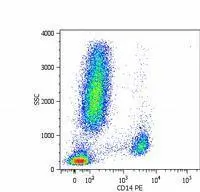
Surface staining of human peripheral blood cells with anti-human CD14 (MEM-15) PE.
CD14 antibody [MEM-15] (PerCP)
GTX80005
ApplicationsFlow Cytometry
Product group Antibodies
ReactivityHuman, Primate
TargetCD14
Overview
- SupplierGeneTex
- Product NameCD14 antibody [MEM-15] (PerCP)
- Delivery Days Customer9
- Antibody SpecificityThis antibody reacts with CD14, a 53-55 kDa GPI (glycosylphosphatidylinositol)-linked membrane glycoprotein expressed on monocytes, macrophages and weakly on granulocytes; also expressed by most tissue macrophages. And this antibody also reacts with solub
- Application Supplier NoteFACS: 10 microl reagent / 100 microl of whole blood or 106 cells in a suspension. *Optimal dilutions/concentrations should be determined by the researcher.Not tested in other applications.
- ApplicationsFlow Cytometry
- CertificationResearch Use Only
- ClonalityMonoclonal
- Clone IDMEM-15
- ConjugatePerCP
- Gene ID929
- Target nameCD14
- Target descriptionCD14 molecule
- Target synonymsmonocyte differentiation antigen CD14; myeloid cell-specific leucine-rich glycoprotein
- HostMouse
- IsotypeIgG1
- Protein IDP08571
- Protein NameMonocyte differentiation antigen CD14
- Scientific DescriptionThe protein encoded by this gene is a surface antigen that is preferentially expressed on monocytes/macrophages. It cooperates with other proteins to mediate the innate immune response to bacterial lipopolysaccharide. Alternative splicing results in multiple transcript variants encoding the same protein. [provided by RefSeq, Mar 2010]
- ReactivityHuman, Primate
- Storage Instruction2°C to 8°C
- UNSPSC12352203
References
- Internalization of Polymeric Bacterial Peptidoglycan Occurs through Either Actin or Dynamin Dependent Pathways. Popescu NI et al., 2022 Mar 3, MicroorganismsRead more
